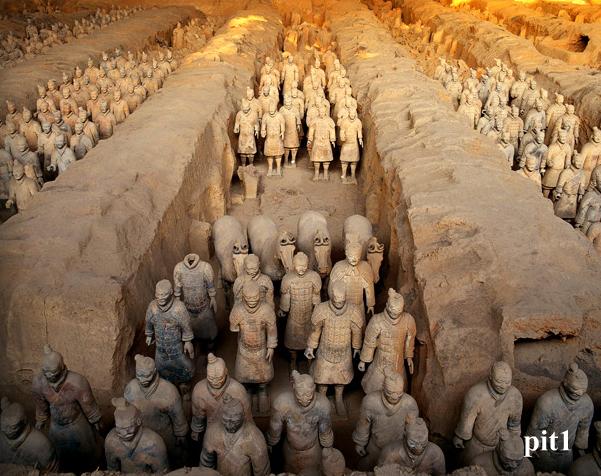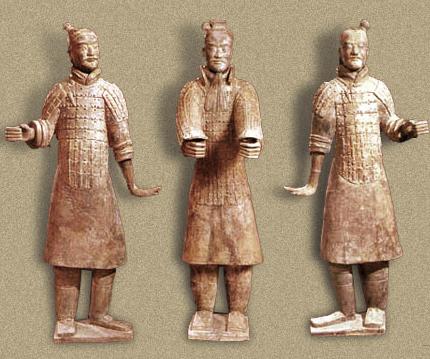The underground battle formation Four pits have been discovered thus far, arranged in breath-taking battle formation. The pits are named Pit 1, 2, 3, and 4. Pit 3 is the headquarters. Pit 1, 2, and 4 form a 品-shape array, one of the classic battle formations in ancient China.
Pit 1 contains the infantry, archers and chariots. Pit 2 mixes cavalry, chariots, and archers. Pit 4 has nothing in it because an uprising spread throughout the whole country after the first three were built. Archeologists believe it should have has a similar arrangement to Pit 2.
When attacking an enemy, the Qin army might have proceeded by having its archers open fire from a distance, the cavalrymen and charioteers would then charge to break the enemy’s line. Finally, the infantry would advance.
Pit 1

Pit 1: Over 6,000 terracotta warriors and horses were discovered in Pit 1. Then partition walls, made of compacted earth, divide the pit into eleven corridors. The arm or-clad infantrymen, standing in rows and holding long-shafted weapons, are the main body of the formation and represent the principal force.
At the east end of the pit stand three rows of archers in battle tunics and puttees, 70 archers in each row, totaling 210 altogether. They constitute the vanguard. The arrangement of three rows of archers is believed to have made continuous shooting possible. The warriors in the second and third rows would have enough time to string their arrows while the first row stood shooting. The Qin crossbows are estimated to have had a range of 300 meters and to have been capable of killing an enemy within 150 meters.
Pit 2
Pit 2: The 1,300 terracotta warriors and horses Pit 2 contains were arranged into four military units. They could attack independently or en mass.
The most eye-catching are the cavalry since chariots and infantry dominated the battlefields at that time. Originally a nomadic tribe, the Qin state topped its rival states in developing and taking advantage of the cavalry.
To provide strong war horses, the Qin government set up an organization specializing in horse issues including breeding, choosing, and training. They had strict criteria about the horses’ height, speed, and strength. For instance, the horses were supposed to be about 1.75 meters high. If the horses failed to meet the set requirements, those who offered or trained them would be punished.

Chariots constitute the major part of this arrangement. Three charioteers armed with long-range weapons stand on each chariot.
